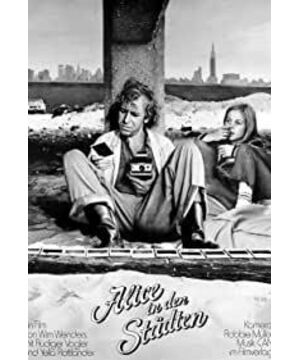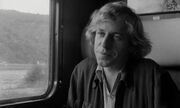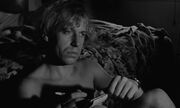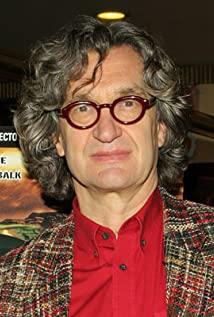Winter, a 31-year-old German journalist, travels across the United States to write about Americana for German readers. In the 1970s in the Western world, it was the time when Europeans rediscovered New Yorkers. They embraced American-style freedom and wealth, but were deeply lost in American-style mass culture and felt lost. When Winter crossed the United States and arrived in New York, the center of the world, he suddenly found that he had lost the ability to write, and the situation was just like its name: deep cold, loneliness, and indifference. Apparently this is director Wenders' most beloved screen hero image (as Wenders' German Wenders pronounces winter), the modern knight has fallen into a mental crisis in the role switch from Europe to the United States: can't find The meaning of individual existence cannot be found true, so it is difficult to communicate with people in the mind, and even cannot write.
All Winter can do is shoot every moment. He used a Polaroid camera that was ready to go, and with a click, the picture came out, and the scenery slowly appeared on the film. Only at this moment did Winter catch a tinge of dubious realism from the image. Because of the shooting, he did not write a word, and the price he paid for it was that he had to go back to Germany with three hundred dollars. In this way, Winter met Alice in the revolving door of the airport, and also encountered travel.
The uncle takes a little loli on a trip, but it is not the popular gangster story of a lolicon uncle and an uncle controlling a loli, nor is it a modern fairy tale in which adults and children conspire together such as "Killer Leon", or even "Central". A fable about the roots of faith in "The Station". I just want to say that they embark on an unknown journey together, because the unknown is so real. From New York to Amsterdam, from the Netherlands to Germany, Winter, who has suffered a crisis of "reality", has not yet realized that the journey itself is the most real, and all this will be unfolded slowly by Alice's wandering.
Let's talk about their roaming first.
In the last century, "Alice" roamed the dream world and the mirror world ignorantly. This time, she was also navigating the city ignorantly, never expecting to save an uncle's soul. At first, Winter took Alice with a clear intention: he was just taking care of Alice for her mother, and when her mother broke up, he tried to take her to her grandmother's house. Because of the existence of this "specific purpose", no real communication has been established between Winter and Alice, and Alice is Winter's burden. To get rid of her, Winter even handed Alice over to the local police station at one point. However, that all changed when Alice sneaked out of the police station and returned to Winter's hands. Winter slowly realized that it wasn't important that he took Alice to find a home, it was the fact that they traveled together. During the trip, Alice kept releasing the children's most genuine joys and sorrows. She would say "I'm hungry", "I'm thirsty", "You just want to get rid of me" angrily, and tell Winter with the solemnity of a runaway prisoner, "I'm from the police station. Run away, the food there is really bad!". The undisguised emotional expression makes Winter more and more open to the loneliness in his heart and realizes the authenticity of his existence.
The most profound exposure of Winter's change in the film is a story he made up for Alice: Once upon a time, a little boy and his mother went for a walk in the forest, the mother rested, the little boy ran along the stream alone, and saw There is a knight on the bridge. The knight disappeared from his field of vision, he chased after him, but came to a highway with cars coming and going. So the little boy got into the truck, full of joy, went to the beach, and thought of his mother again.
The story is not over, Alice has fallen asleep, but Winter smiled faintly. Because this story is a poetic rendition of the film. The knight is the most typical image in German romantic literature and art, the embodiment of beauty and truth, and a symbol of authenticity. The little boy traces his way from the old German traditions to the highways of modern civilization. He gets lost in the knight and gets into the truck; he walks out of the forest and into the highway. The old symbol disappears and a new one is born, which is travel by car. The little boy is Winter and Alice. Just as Alice took a photo for Winter, Winter's rough and textured head was superimposed with Alice's head, which all showed that they confirmed each other's existence in their wanderings.
Let's talk about the meaning of roaming.
Alice's roaming may only get good childhood memories when she grows up, but inadvertently reconstructs the meaning of Winter's individual existence. During the trip, Winter never put down the Polaroid camera, because photography entrusted him with a bleak sense of reality. Wenders wrote in his famous collection of photographic poems "once": "Photography is an action that goes into time, tore something out of it, and then freezes it in another lasting form." The particularity of the Polaroid camera is that There are no negatives, so each photo is unique and cannot be duplicated. So Winter is like a shot to mark time to prove that he is real. Since Polaroid photos take a while from shooting to development, the wait is extremely long for Winter, because what he is waiting for is not the photo, but the reality.
But this sense of reality is fragile. When Winter and Alice finally found the exact same grandma's house as in the photo, Winter initially exclaimed excitedly, "It's incredible!" It's as if the photo was resurrected. But Alice then announced that her grandmother had already moved out, and the authenticity of the photo collapsed. Winter then realized that he still had to write, had to write, and that photos alone couldn't get authenticity. Viewers notice that, starting in the middle of the film, Winter gradually picks up the pen, recording the bits and pieces that we can or cannot guess. That's exactly what his travels with Alice conferred. As a result, Alice seems to be his Polaroid "photograph", using her innocence and "maturity" to slowly present the truth during the travel, and thus reconstruct Winter's meaning world. In the end, Winter not only finally regained the lost meaning, but also the ability to write. At the end of the film, Winter is for the first time in the film to point the camera at a mother and child instead of just the scenery. Winter's cold wave receded, and he saw spring through Alice.
An early image of Wenders, the film has yet to become his signature road movie. Winter and Alice took planes, trains, cars, buses, elevated railways, yachts, and ferries; they stopped at various hotels, ice cream parlors, restaurants (one restaurant still played Chinese songs), and police stations; they walked Cross the corners of cities, suburbs, villages and towns. Travel is becoming more and more dreamy, especially the unique elevated railway hanging in the air, which makes people seem to have stepped into the magical world of fairy tales. In fact, it doesn't matter where they are, as long as they are always on the road. From this alone, we have seen the melancholy taste of "Paris, Texas".
"Alice" has become synonymous with roaming. In 19th century England, Alice once roamed Wonderland and the World in the Mirror. For two hundred years, Alice's travels have been like the footsteps of every child who has experienced childhood, including me. My first English tape was "Alice in Wonderland", and Tim Burton's latest remake will debut next year, so blessed are those born in 2000. However, as far as Wenders is concerned, this is not a fairy tale, but a fact of modernity gradually revealed on black and white film. Yes, the movie depicts Alice's travels, and it's more of Winter's travels, but it's ultimately Wenders' travels.
Published in a 2010 issue of "Watching Movies" "No. 66 Tiandi Street"
View more about Alice in the Cities reviews










